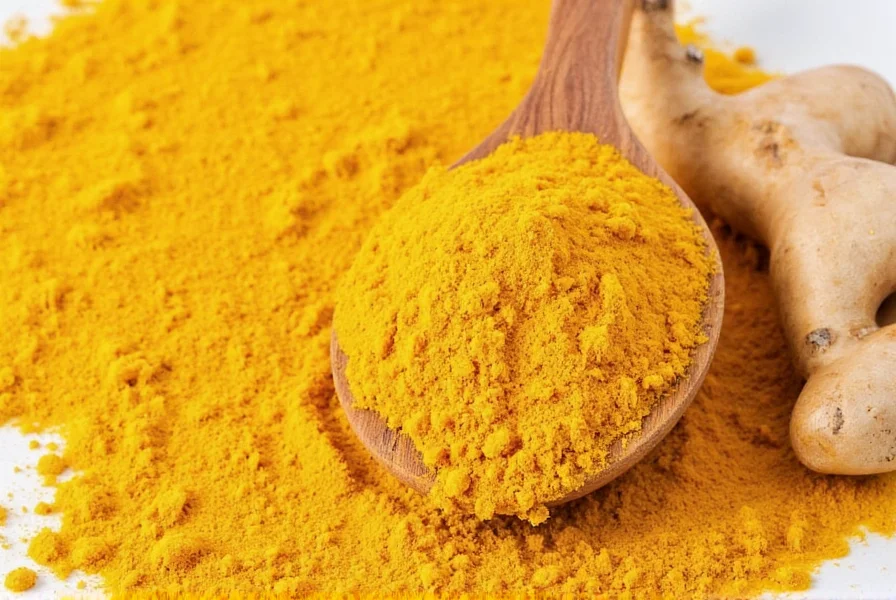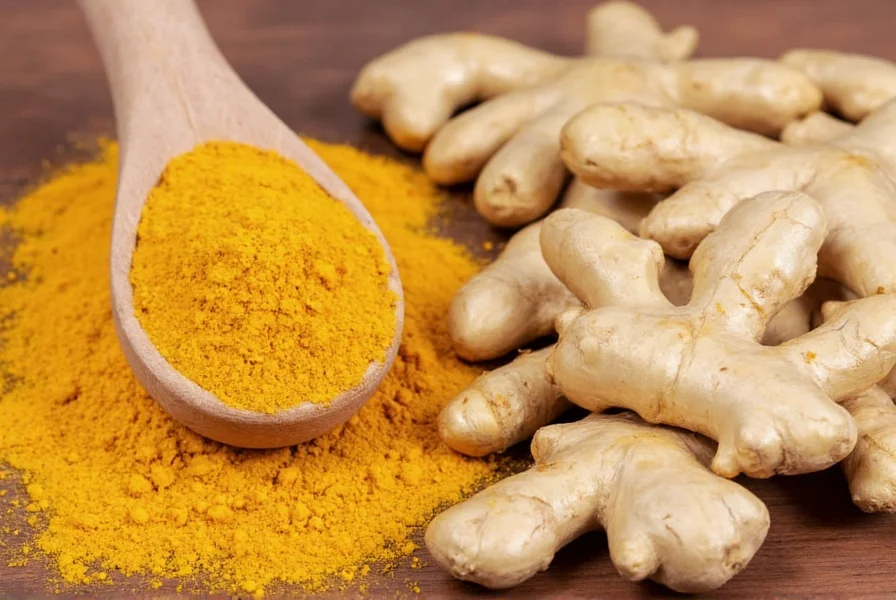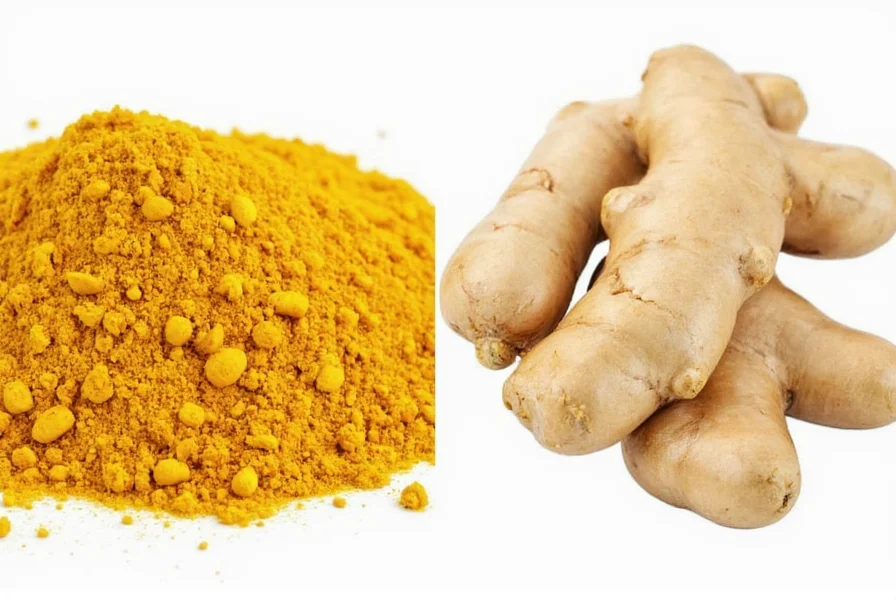When comparing turmeric vs ginger, it's essential to understand that while these golden-hued spices share some similarities, they offer unique health properties that make each valuable in different scenarios. Both belong to the Zingiberaceae family but have distinct chemical compositions that drive their specific health benefits. This comprehensive comparison examines their nutritional profiles, active compounds, research-backed health benefits, and practical applications to help you determine when to use each spice.
Nutritional Profiles: Turmeric vs Ginger
Understanding the nutritional differences between turmeric and ginger provides insight into their respective health contributions. While both are low in calories, they contain different concentrations of vitamins, minerals, and bioactive compounds that drive their therapeutic effects.
| Nutrient | Per Teaspoon Turmeric (2g) | Per Teaspoon Ginger (2g) |
|---|---|---|
| Calories | 6 | 4 |
| Carbohydrates | 1.4g | 1g |
| Fiber | 0.6g | 0.1g |
| Vitamin C | 0.2mg (0.3% DV) | 0.3mg (0.5% DV) |
| Magnesium | 3.4mg (0.8% DV) | 4.6mg (1.1% DV) |
| Potassium | 34mg (1% DV) | 29mg (0.6% DV) |
| Iron | 0.3mg (1.7% DV) | 0.04mg (0.2% DV) |
| Manganese | 0.2mg (8.7% DV) | 0.03mg (1.3% DV) |
Notably, turmeric contains significantly higher levels of iron and manganese compared to ginger, while ginger provides slightly more magnesium and vitamin C. However, the most important differences lie in their active compounds rather than basic nutrition.
Active Compounds: Curcumin vs Gingerol
The primary therapeutic compounds differentiate turmeric and ginger health benefits substantially:
Turmeric's Key Compound: Curcumin
Curcumin constitutes about 2-8% of turmeric by weight and is responsible for most of turmeric's health benefits. This polyphenol has been extensively studied for its:
- Powerful anti-inflammatory effects (comparable to some pharmaceuticals)
- Antioxidant properties that combat oxidative stress
- Ability to cross the blood-brain barrier, supporting cognitive function
- Enhanced absorption when combined with black pepper (piperine)
Research shows curcumin may help reduce symptoms of arthritis, improve brain-derived neurotrophic factor (BDNF) levels, and potentially lower risk factors for heart disease. However, curcumin has low bioavailability on its own, which is why many supplements include absorption enhancers.
Ginger's Key Compound: Gingerol
Gingerol, particularly 6-gingerol, is ginger's primary bioactive compound and gives the root its characteristic pungency. Gingerol transforms into other compounds like shogaol when dried or cooked, which also have therapeutic properties. Ginger's compounds are particularly effective for:
- Digestive health and nausea relief
- Muscle pain reduction
- Anti-nausea effects (particularly for morning sickness and chemotherapy-induced nausea)
- Natural anti-inflammatory properties
Unlike curcumin, gingerol has relatively good bioavailability, making ginger's benefits more readily accessible through dietary consumption.
Health Benefits Comparison
When evaluating turmeric vs ginger for inflammation, both demonstrate impressive anti-inflammatory properties, but through different mechanisms and with varying effectiveness for specific conditions.
Inflammation and Joint Health
Turmeric, specifically its curcumin content, shows remarkable effectiveness against chronic inflammation. Multiple studies indicate curcumin can inhibit multiple molecules involved in inflammation pathways. A 2016 review published in Food Science & Nutrition found that curcumin supplementation significantly reduced markers of inflammation and improved symptoms in people with arthritis.
Ginger also demonstrates anti-inflammatory effects, particularly for exercise-induced muscle pain. Research in the Journal of Pain showed that daily ginger consumption reduced muscle pain by 25% following intense exercise. For osteoarthritis, both spices show benefits, but turmeric generally demonstrates stronger effects for chronic inflammatory conditions.
Digestive Health
When comparing turmeric and ginger for digestion, ginger emerges as the superior choice for immediate digestive concerns. Ginger stimulates saliva, bile, and gastric enzyme production, accelerating gastric emptying. Clinical trials show ginger can reduce nausea from pregnancy, chemotherapy, and surgery more effectively than many conventional treatments.
Turmeric also supports digestive health but through different mechanisms. It may help reduce symptoms of irritable bowel syndrome (IBS) and has shown promise in managing inflammatory bowel diseases like ulcerative colitis. However, high doses of turmeric may actually cause digestive discomfort in some people.
Brain Health and Cognitive Function
Turmeric has more substantial research supporting its benefits for brain health. Curcumin increases brain-derived neurotrophic factor (BDNF), which supports neuron growth and may delay or reverse brain diseases and age-related cognitive decline. Studies suggest curcumin may improve memory and attention in healthy adults and those with mild cognitive impairment.
Ginger shows some promise for cognitive function as well, with animal studies indicating potential protective effects against Alzheimer's disease, but human research is more limited compared to turmeric.
Cardiovascular Health
Both spices offer cardiovascular benefits, but through different pathways. Turmeric may improve endothelial function (the lining of blood vessels), which is crucial for regulating blood pressure. Ginger demonstrates benefits for cholesterol management, with studies showing it can lower LDL cholesterol and triglycerides.
Culinary Applications and Flavor Profiles
Understanding the difference between turmeric and ginger in cooking is essential for maximizing both flavor and health benefits:
Turmeric in Cooking
- Earthy, slightly bitter flavor with subtle notes of orange and ginger
- Best used with black pepper and healthy fats to enhance curcumin absorption
- Ideal for curries, rice dishes, soups, and golden milk
- Can stain surfaces and fabrics yellow
- Fresh turmeric root has a more complex flavor than powdered form
Ginger in Cooking
- Spicy, pungent, slightly sweet flavor that becomes warmer when cooked
- Works well in both sweet and savory applications
- Excellent in stir-fries, teas, baked goods, and marinades
- Fresh ginger has more potent gingerol than dried forms
- Can be used as a natural preservative due to antimicrobial properties

Safety Considerations and Potential Side Effects
Both spices are generally safe when consumed in culinary amounts, but certain considerations apply when using them medicinally:
Turmeric Considerations
- High doses may interact with blood thinners (warfarin, aspirin)
- May worsen gallbladder issues or kidney stones in susceptible individuals
- Curcumin supplements can cause digestive upset in some people
- Pregnant women should avoid medicinal doses but can safely consume culinary amounts
Ginger Considerations
- Generally well-tolerated, but high doses may cause heartburn or mouth irritation
- May interact with blood thinners and diabetes medications
- Generally considered safe for pregnancy-related nausea (consult physician)
- Rare cases of allergic reactions reported
Which Should You Choose: Turmeric or Ginger?
The answer to which is better turmeric or ginger depends entirely on your specific health goals:
- Choose turmeric when: addressing chronic inflammation, supporting brain health, managing arthritis symptoms, or seeking antioxidant protection
- Choose ginger when: treating nausea, improving digestion, reducing muscle soreness, or addressing acute inflammation
For many health goals, using turmeric and ginger together creates a synergistic effect. Their complementary anti-inflammatory properties work through different pathways, potentially providing broader protection than either alone. Many traditional medicine systems, including Ayurveda and Traditional Chinese Medicine, combine these spices for enhanced therapeutic effects.
Practical Tips for Maximizing Benefits
To get the most from these spices in your daily routine:
- For turmeric: Always pair with black pepper (just 1/20th of a teaspoon) and a healthy fat (like coconut oil or olive oil) to increase curcumin absorption by up to 2,000%
- For ginger: Fresh is generally more potent than dried for nausea relief, while dried ginger may have higher concentrations of certain beneficial compounds
- Consider making a daily tonic with both spices: simmer fresh turmeric and ginger in water, add lemon and honey
- Store fresh roots in the refrigerator for up to three weeks or freeze for longer storage
- When using supplements, look for standardized extracts with proven bioavailability

Conclusion: Complementary Powerhouses
Rather than viewing turmeric and ginger as competitors, recognize them as complementary therapeutic agents. The turmeric ginger comparison for inflammation reveals that while turmeric generally offers stronger anti-inflammatory effects for chronic conditions, ginger provides superior relief for digestive issues and acute inflammation. Incorporating both into your diet provides the broadest spectrum of health benefits. For specific health concerns, consult with a healthcare provider to determine appropriate usage, especially if you have underlying health conditions or take medications.
What's the main difference between turmeric and ginger?
The primary difference lies in their active compounds and resulting health benefits. Turmeric contains curcumin, which excels at reducing chronic inflammation and supporting brain health, while ginger's gingerol is superior for digestive issues, nausea relief, and acute inflammation. Though both are anti-inflammatory, they work through different biological pathways and are most effective for different health concerns.
Can I take turmeric and ginger together?
Yes, turmeric and ginger can be safely consumed together and often create synergistic effects. Many traditional medicine systems combine these spices for enhanced therapeutic benefits. When taken together, they provide broader anti-inflammatory coverage as they work through different pathways. Just be mindful of potential interactions if you're taking blood thinners or have gallbladder issues, and consult your healthcare provider if you have specific health concerns.
Which is better for inflammation: turmeric or ginger?
For chronic inflammation conditions like arthritis, turmeric generally shows stronger effects due to curcumin's potent anti-inflammatory properties. However, for acute inflammation such as muscle soreness after exercise, ginger may provide more immediate relief. Research suggests turmeric's effects on inflammatory markers are typically more pronounced, but the best choice depends on the specific type and cause of inflammation you're addressing.
How much turmeric or ginger should I consume daily for health benefits?
For culinary use, 1-3 grams (about 1/2 to 1.5 teaspoons) of powdered turmeric or 2-4 grams of fresh ginger daily provides health benefits. For therapeutic effects, studies often use 500-2,000 mg of curcumin (from turmeric) or 1,000-1,500 mg of ginger extract daily. When using fresh forms, 1-3 inches of root provides approximately 1,500-3,000 mg. Always start with lower amounts to assess tolerance, and consult a healthcare provider for medicinal dosing.
Does turmeric really work better with black pepper?
Yes, research confirms that piperine in black pepper significantly enhances curcumin absorption. Studies show that adding just 1/20th of a teaspoon of black pepper can increase curcumin bioavailability by up to 2,000%. This is because piperine inhibits certain digestive enzymes and increases intestinal absorption. For maximum benefit, always consume turmeric with a small amount of black pepper and a healthy fat source like coconut oil or olive oil.











 浙公网安备
33010002000092号
浙公网安备
33010002000092号 浙B2-20120091-4
浙B2-20120091-4